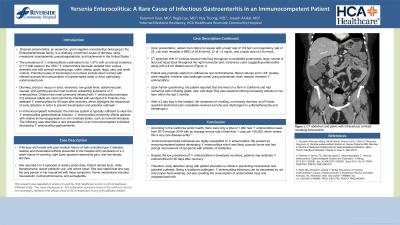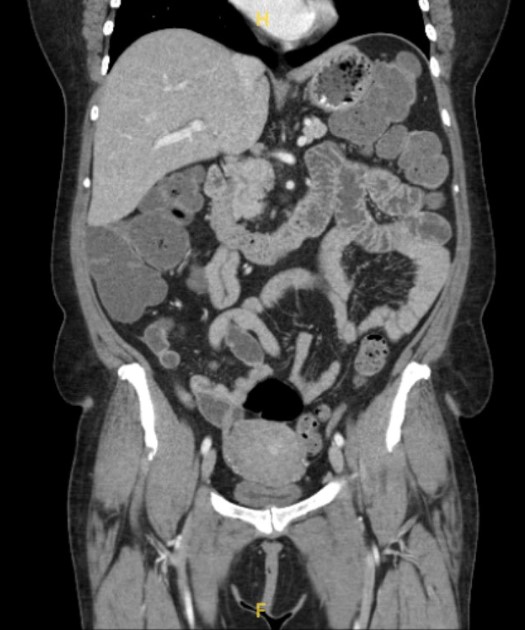Monday Poster Session
Category: Colon
P2028 - Yersinia Enterocolitica: A Rare Cause of Infectious Gastroenteritis in an Immunocompetent Patient
Monday, October 28, 2024
10:30 AM - 4:00 PM ET
Location: Exhibit Hall E

Has Audio
- KK
Karamvir Kaur, MD
HCA Riverside Community Hospital
Riverside, CA
Presenting Author(s)
Karamvir Kaur, MD1, Regis Lee, DO1, Huy Truong, DO1, Joseph J. Alukal, MD2
1HCA Riverside Community Hospital, Riverside, CA; 2University of California Riverside, Riverside, CA
Introduction: The prevalence of Yersiniosis enterocolitica (YE) is estimated to be 1.97% with an annual incidence of 117,000 cases in the USA. Infections often occur after contact with infected animals or ingestion of contaminated food. YE commonly affects patients with relative immunosuppression or iron overload states, such as hemochromatosis. We present a case of an immunocompetent individual developing YE gastroenteritis.
Case Description/Methods: A 48-year-old female with a history of well controlled diabetes and rheumatoid arthritis (not on immunomodulators) presented to the hospital with vomiting, RLQ abdominal pain and non-bloody diarrhea of 4 weeks duration. She reported 3 to 4 episodes of watery stools daily but denied fever, hematochezia as well as exposure to recent antibiotics and recent travel. Medications included crestor, hydroxychloroquine and ozempic. She met criteria for sepsis with a HR of 118 bpm, RR of 22 and had right lower quadrant tenderness. Lab work revealed a WBC of 24.8 k/mm3, Cr of 1.2 mg/dL and a lactic acid of 2.8 mmol/L. CT abdomen with IV contrast showed mild fluid throughout a nondilated small bowel, large volume of fluid and liquid stool throughout the right hemicolon and transverse colon suggesting enterocolitis along with a 8 cm dilated cecum (Figure 1). Patient was started on ceftriaxone and metronidazole. Blood cultures and Cdiff studies were negative, however stool pathogen panel using polymerase chain reaction (PCR) revealed YE. Upon further questioning, the patient reported that she lived on a farm in southern California and had numerous pets including goats, cats, and dogs. She also reported noticing increasing rodents in her farm within the last 2 months. After a 3 day stay in the hospital, her symptoms resolved and she was discharged on bactrim.
Discussion: According to the California public health, there were only a total of 1,362 new yersiniosis cases from 2013 through 2019 with an average annual rate of less than 1 case per 100,000, which makes this a very rare disease entity. Immunocompromised individuals are highly susceptible to YE. We present an immunocompetent patient developing YE which was likely zoonotic borne and had improvement of symptoms with initiation of antibiotics. Despite the low prevalence of YE in developed countries, patients may defecate YE for 90 days after recovery. Therefore, early detection along with patient education is critical in preventing transmission and potential outbreak.

Disclosures:
Karamvir Kaur, MD1, Regis Lee, DO1, Huy Truong, DO1, Joseph J. Alukal, MD2. P2028 - Yersinia Enterocolitica: A Rare Cause of Infectious Gastroenteritis in an Immunocompetent Patient, ACG 2024 Annual Scientific Meeting Abstracts. Philadelphia, PA: American College of Gastroenterology.
1HCA Riverside Community Hospital, Riverside, CA; 2University of California Riverside, Riverside, CA
Introduction: The prevalence of Yersiniosis enterocolitica (YE) is estimated to be 1.97% with an annual incidence of 117,000 cases in the USA. Infections often occur after contact with infected animals or ingestion of contaminated food. YE commonly affects patients with relative immunosuppression or iron overload states, such as hemochromatosis. We present a case of an immunocompetent individual developing YE gastroenteritis.
Case Description/Methods: A 48-year-old female with a history of well controlled diabetes and rheumatoid arthritis (not on immunomodulators) presented to the hospital with vomiting, RLQ abdominal pain and non-bloody diarrhea of 4 weeks duration. She reported 3 to 4 episodes of watery stools daily but denied fever, hematochezia as well as exposure to recent antibiotics and recent travel. Medications included crestor, hydroxychloroquine and ozempic. She met criteria for sepsis with a HR of 118 bpm, RR of 22 and had right lower quadrant tenderness. Lab work revealed a WBC of 24.8 k/mm3, Cr of 1.2 mg/dL and a lactic acid of 2.8 mmol/L. CT abdomen with IV contrast showed mild fluid throughout a nondilated small bowel, large volume of fluid and liquid stool throughout the right hemicolon and transverse colon suggesting enterocolitis along with a 8 cm dilated cecum (Figure 1). Patient was started on ceftriaxone and metronidazole. Blood cultures and Cdiff studies were negative, however stool pathogen panel using polymerase chain reaction (PCR) revealed YE. Upon further questioning, the patient reported that she lived on a farm in southern California and had numerous pets including goats, cats, and dogs. She also reported noticing increasing rodents in her farm within the last 2 months. After a 3 day stay in the hospital, her symptoms resolved and she was discharged on bactrim.
Discussion: According to the California public health, there were only a total of 1,362 new yersiniosis cases from 2013 through 2019 with an average annual rate of less than 1 case per 100,000, which makes this a very rare disease entity. Immunocompromised individuals are highly susceptible to YE. We present an immunocompetent patient developing YE which was likely zoonotic borne and had improvement of symptoms with initiation of antibiotics. Despite the low prevalence of YE in developed countries, patients may defecate YE for 90 days after recovery. Therefore, early detection along with patient education is critical in preventing transmission and potential outbreak.

Figure: Figure 1: CT abdomen and pelvis with intravenous contrast revealing enterocolitis
Disclosures:
Karamvir Kaur indicated no relevant financial relationships.
Regis Lee indicated no relevant financial relationships.
Huy Truong indicated no relevant financial relationships.
Joseph Alukal indicated no relevant financial relationships.
Karamvir Kaur, MD1, Regis Lee, DO1, Huy Truong, DO1, Joseph J. Alukal, MD2. P2028 - Yersinia Enterocolitica: A Rare Cause of Infectious Gastroenteritis in an Immunocompetent Patient, ACG 2024 Annual Scientific Meeting Abstracts. Philadelphia, PA: American College of Gastroenterology.
